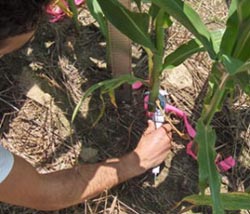Corn Yield Prediction Model Uses Simple Measurements at a Specific Growth Stage

Photo courtesy of Spyridon Mourtzinis.<br>Measuring the stem diameter of corn crops.<br>
A new study published in the July-August issue of Agronomy Journal describes a robust model that uses easily obtained measurements, such as plant morphology and precipitation, collected specifically at the silking growth stage of the plant. The new model could help both growers and industry maximize their profits and efficiency.
Forecasting crop yield can be extremely useful for farmers. If they have an idea of the amount of yield they can expect, they can contract their corn prior to harvest, often securing a more competitive price than if they were to wait until after harvest. Likewise, industry can benefit from yield predictions by better planning the logistics of their business. But dependable forecasts can be difficult to find.
Several methods of predicting and modeling crop yields have been used in the past with varying success. Statistical models often don’t take into account characteristics of the plants, the weather, or the management practices limiting their usefulness. Some models are based on information from just a single year or location.
“When you develop a model using single location or year data, it will have limited practical applications,” explains Spyridon Mourtzinis, lead author of the study. “You don’t include variability from multiple environments.”
The new study from Mourtzinis and his co-authors from Auburn University found a more robust model for predicting both corn grain and stover yield. The model uses equations calculated with information about nitrogen fertilization rates, precipitation, and plant morphology, such as plant height, stem diameter, height of the first ear, number of forming ears, and plant population.
“Previous attempts were mainly looking at weather factors,” says Francisco Arriaga, co-author of the study and now an assistant professor at the University of Wisconsin-Madison. “This approach has other factors included in the model, and that is an important strength.”
The timing of the measurements is also an important aspect of the model. Mourtzinis took weekly measurements from over 100 plots throughout the growing season to find the best window during which to collect data to be used in the equations. The time-consuming work paid off.
“We looked at all the vegetative states to see which one was best, and it turned out to be the R1 growth stage,” explains Arriaga. “Other models tried to take measurements earlier, but that may be why they had poor results. Things change as the season goes by, and the stage we found was the critical one.”
The R1 or silking growth stage, when silks are first visible outside the husks, is about two to two and half months before harvest. This model, then, would provide predictions early enough to affect crop prices and to allow industries to plan their operations. While even earlier predictions might be possible, they would depend on better forecasting of weather, which can greatly affect yields. Weather changes significantly throughout the growing season, and current forecasts are not dependable.
Another reason that the new model is robust is because data was collected at two different sites in Alabama over three years. The equations used in the current model, then, translated over six sets of data suggesting that it could be used in a variety of environments. Whether that is true is a goal of future experiments.
“It would be interesting to test the equations across a lot more environments now that we know which growth stage to target,” says Arriaga.
Future studies will also test the model with other corn hybrids and management practices. As more data is collected from a variety of environments and growing conditions, the authors are hopeful that the model will continue to be an accurate predictor of corn yield.
“We need to be open-minded,” says Mourtzinis. “The equations might change a bit when we get more data from more environments, but I think we can build on the current model.”
View the abstract at http://dx.doi.org/doi:10.2134/agronj2012.0393
To obtain a copy of the complete article, please contact Madeline Fisher at 608-268-3973, mfisher@sciencesocieties.org or Caroline Schneider at 608-268-3976, cschneider@sciencesocieties.org.
Spyridon Mourtzinis
szm0020@tigermail.auburn.edu
The full article is available for no charge for 30 days following the date of this summary. View the abstract at http://dx.doi.org/doi:10.2134/agronj2012.0393.
A peer-reviewed international journal of agriculture and natural resource sciences, Agronomy Journal is published six times a year by the American Society of Agronomy, with articles relating to original research in soil science, crop science, agroclimatology and agronomic modeling, production agriculture, and software. For more information visit: www.agronomy.org/publications/aj
The American Society of Agronomy (ASA) www.agronomy.org, is a scientific society helping its 8,000+ members advance the disciplines and practices of agronomy by supporting professional growth and science policy initiatives, and by providing quality, research-based publications and a variety of member services.
Media Contact
More Information:
http://www.agronomy.orgAll latest news from the category: Agricultural and Forestry Science
Newest articles

Compact LCOS Microdisplay with Fast CMOS Backplane
…for High-Speed Light Modulation. Researchers from the Fraunhofer Institute for Photonic Microsystems IPMS, in collaboration with HOLOEYE Photonics AG, have developed a compact LCOS microdisplay with high refresh rates that…

New perspectives for material detection
CRC MARIE enters third funding period: A major success for terahertz research: Scientists at the University of Duisburg-Essen and the Ruhr University Bochum have been researching mobile material detection since…

CD Laboratory at TU Graz Researches New Semiconductor Materials
Using energy- and resource-saving methods, a research team at the Institute of Inorganic Chemistry at TU Graz aims to produce high-quality doped silicon layers for the electronics and solar industries….



